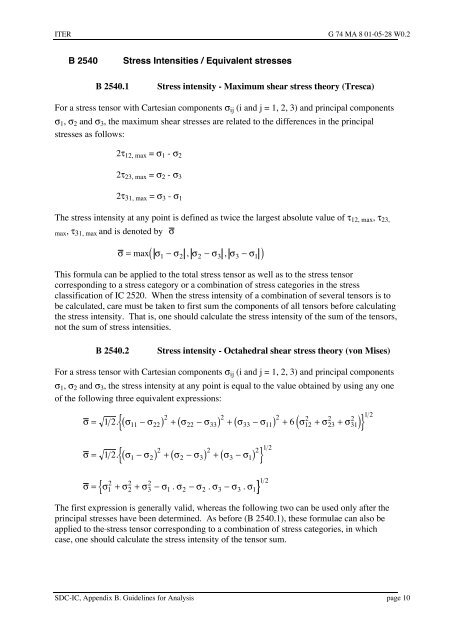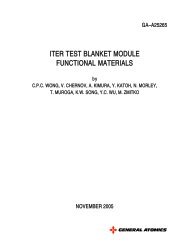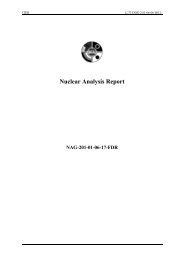iter structural design criteria for in-vessel components (sdc-ic)
iter structural design criteria for in-vessel components (sdc-ic)
iter structural design criteria for in-vessel components (sdc-ic)
Create successful ePaper yourself
Turn your PDF publications into a flip-book with our unique Google optimized e-Paper software.
ITER G 74 MA 8 01-05-28 W0.2<br />
B 2540 Stress Intensities / Equivalent stresses<br />
BÊ2540.1 Stress <strong>in</strong>tensity - Maximum shear stress theory (Tresca)<br />
For a stress tensor with Cartesian <strong>components</strong> sij (i and j = 1, 2, 3) and pr<strong>in</strong>cipal <strong>components</strong><br />
s1, s2 and s3, the maximum shear stresses are related to the differences <strong>in</strong> the pr<strong>in</strong>cipal<br />
stresses as follows:<br />
2t12, max = s1 - s2<br />
2t23, max = s2 - s3<br />
2t31, max = s3 - s1<br />
The stress <strong>in</strong>tensity at any po<strong>in</strong>t is def<strong>in</strong>ed as tw<strong>ic</strong>e the largest absolute value of t12, max, t23,<br />
max, t31, max and is denoted by s<br />
( 1 2 2 3 3 1 )<br />
s = max s - s , s - s , s - s<br />
This <strong>for</strong>mula can be applied to the total stress tensor as well as to the stress tensor<br />
correspond<strong>in</strong>g to a stress category or a comb<strong>in</strong>ation of stress categories <strong>in</strong> the stress<br />
classif<strong>ic</strong>ation of ICÊ2520. When the stress <strong>in</strong>tensity of a comb<strong>in</strong>ation of several tensors is to<br />
be calculated, care must be taken to first sum the <strong>components</strong> of all tensors be<strong>for</strong>e calculat<strong>in</strong>g<br />
the stress <strong>in</strong>tensity. That is, one should calculate the stress <strong>in</strong>tensity of the sum of the tensors,<br />
not the sum of stress <strong>in</strong>tensities.<br />
BÊ2540.2 Stress <strong>in</strong>tensity - Octahedral shear stress theory (von Mises)<br />
For a stress tensor with Cartesian <strong>components</strong> sij (i and j = 1, 2, 3) and pr<strong>in</strong>cipal <strong>components</strong><br />
s1, s2 and s3, the stress <strong>in</strong>tensity at any po<strong>in</strong>t is equal to the value obta<strong>in</strong>ed by us<strong>in</strong>g any one<br />
of the follow<strong>in</strong>g three equivalent expressions:<br />
2<br />
2<br />
2<br />
{ ( 11 22 ) + ( 22 - 33 ) + ( 33 - 11)<br />
+ ( 12 + + ) }<br />
2 2<br />
23 31<br />
2<br />
s = 12. s - s s s s s 6 s s s<br />
2<br />
2<br />
{ ( 1 2)<br />
+ ( 2 - 3)<br />
+ ( 3 - 1)<br />
}<br />
s = 12.<br />
s - s s s s s<br />
{<br />
2<br />
s = s + s + s - s . s - s . s - s . s } 12<br />
1 2<br />
2<br />
3 2<br />
1 2 2 3 3 1<br />
The first expression is generally valid, whereas the follow<strong>in</strong>g two can be used only after the<br />
pr<strong>in</strong>cipal stresses have been determ<strong>in</strong>ed. As be<strong>for</strong>e (BÊ2540.1), these <strong>for</strong>mulae can also be<br />
applied to the stress tensor correspond<strong>in</strong>g to a comb<strong>in</strong>ation of stress categories, <strong>in</strong> wh<strong>ic</strong>h<br />
case, one should calculate the stress <strong>in</strong>tensity of the tensor sum.<br />
SDC-IC, Appendix B. Guidel<strong>in</strong>es <strong>for</strong> Analysis page 10<br />
2 12<br />
12




